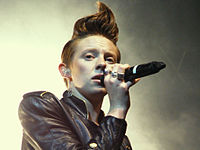Quiff
Appearance
This article needs additional citations for verification. (September 2014) |

The quiff is a hairstyle that combines the 1950s pompadour hairstyle, the 1950s flattop, and sometimes a mohawk. The hairstyle was a staple in the British 'Teddy Boy' movement, but became popular again in Europe in the early 1980s and faced a resurgence in popularity during the '90s.[1]
Origin of the word
The etymology of the word "quiff" is uncertain, and several proposals have been suggested for its origin.
- It may derive from the Hindi word quoff, meaning hair slicked back.
- It may owe its origin to the French word coiffe, which can mean either a hairstyle or, going further back, the mail that knights wore over their heads and under their helmets.
- Another possible candidate for its origin is the Dutch word kuif, meaning "crest." The Dutch name for Tintin, who sports a quiff, is Kuifje, which is the diminutive of the same word.
Styles
The modern-day quiff includes plenty of hair at the front of the top of the head, receding into shorter hair at the back with a trimmed back and sides.
The Japanese punch perm, a favorite among Yakuza (organized criminals) and Bōsōzoku (biker gangs), is similar to the quiff.
See also
Wikimedia Commons has media related to Quiff.
References
- ^ Averill, Farah. "Top 6: Timeless Hairstyles". UK.AskMen.com. Ziff Davis. p. 5. Retrieved 2014-10-11.
